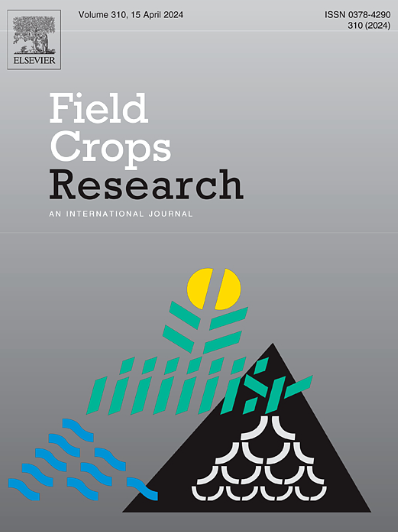印度尼西亚东爪哇玉米、大豆和绿豆间作系统的生产性能
IF 6.4
1区 农林科学
Q1 AGRONOMY
引用次数: 0
摘要
玉米(Zea mays L.)-大豆(Glycine max L. (Merr.))间作可提高土地和资源利用效率,但其效果取决于物种相互作用、环境条件和管理。在热带气候条件下,在没有重大资源短缺的情况下,关于不同配置下间作性能的资料很少。目的研究在东爪哇热带气候条件下,适度施肥条件下玉米、大豆、绿豆同步播种、洪水灌溉的玉米-大豆间作系统的土地利用效率,并评价窄宽行间作和绿豆间作对土地利用效率和生产力的影响。方法在四个生长季节进行实验。两种替代系统采用两行玉米和四行大豆,按当地标准间距或缩短玉米行间距离,以提高大豆的辐射拦截能力(窄宽行系统)。两种添加系统引入绿豆(Vigna radiata L.)或额外的大豆行。结果复合间作的土地利用效率(平均LER≈1.10)高于单一间作和替代间作的土地利用效率(平均LER = 0.93)。窄宽行制提高了大豆的生产性能和整体LER,但对玉米产量没有显著影响。大豆在添加剂系统中的表现优于绿豆,而绿豆在玉米行附近表现不佳。在东爪哇,推荐施肥和充足水分同时播种的玉米-大豆替代间作系统不具有土地利用优势。附加系统提供了边际效益。这些发现与新出现的证据一致,即在同时播种和资源投入充足的情况下,间作的产量效益很小。本文章由计算机程序翻译,如有差异,请以英文原文为准。
Performance of maize, soybean, and mung bean intercropping systems in East Java, Indonesia
Context
Maize (Zea mays L.)-soybean (Glycine max L. (Merr.)) intercropping can enhance land and resource use efficiency, but its performance depends on species interactions, environmental conditions, and management. There is little information on intercrop performance under different configurations without major resource deficits in a tropical climate.
Objectives
We determined the land use efficency of simultaneously sown, flood irrigated maize-soybean intercropping systems comprising maize, soybean and mung bean in the tropical climate of East Java with moderate fertilizer input, and evaluated how narrow-wide row systems and incorporation of mung bean changed the land use efficiency and productivity.
Methods
Experiments were done during four growing seasons. Two replacement systems used two maize and four soybean rows in alternating strips at local standard spacing or at reduced maize inter-row distances to improve soybean radiation interception (narrow-wide row system). Two additive systems introduced mung bean (Vigna radiata L.) or additional soybean rows.
Results
Additive intercrops had higher land use efficiency (average LER ≈ 1.10) than sole crops or replacement systems (LER = 0.93). The narrow-wide row system improved soybean performance and overall LER without significantly affecting maize yield. Soybean outperformed mung bean in additive systems, while mung bean struggled near maize rows.
Synthesis and implications
Simultaneously sown maize-soybean replacement intercropping systems with recommended fertilizer inputs and sufficient water did not have a land use advantage in East Java. Additive systems provided marginal benefits. These findings align with emerging evidence that yield benefits of intercropping are small under simultaneous sowing and adequate resource inputs.
求助全文
通过发布文献求助,成功后即可免费获取论文全文。
去求助
来源期刊

Field Crops Research
农林科学-农艺学
CiteScore
9.60
自引率
12.10%
发文量
307
审稿时长
46 days
期刊介绍:
Field Crops Research is an international journal publishing scientific articles on:
√ experimental and modelling research at field, farm and landscape levels
on temperate and tropical crops and cropping systems,
with a focus on crop ecology and physiology, agronomy, and plant genetics and breeding.
 求助内容:
求助内容: 应助结果提醒方式:
应助结果提醒方式:


